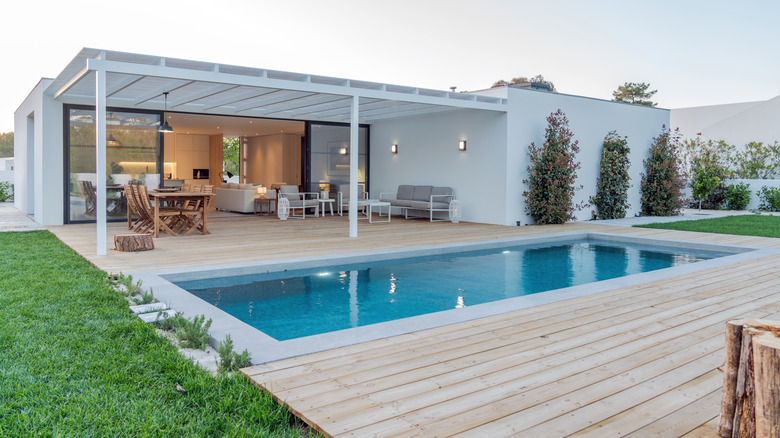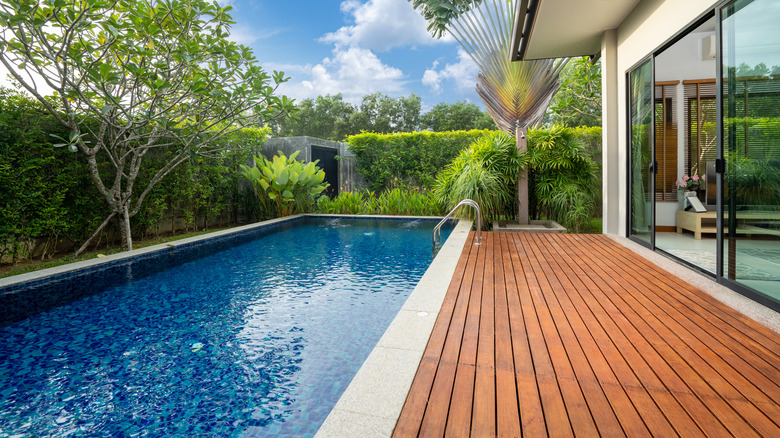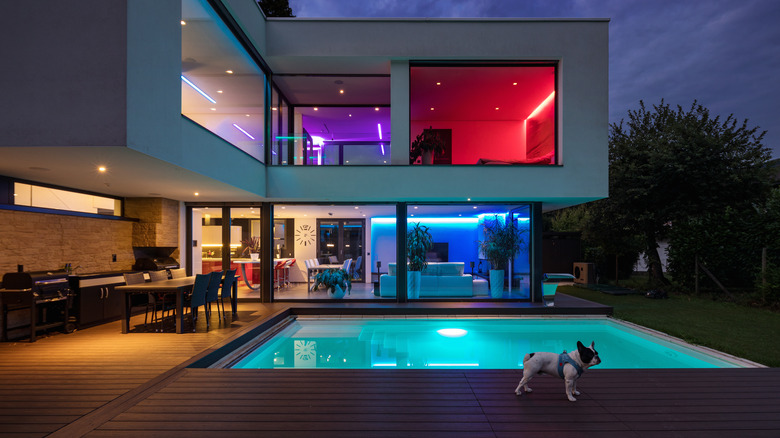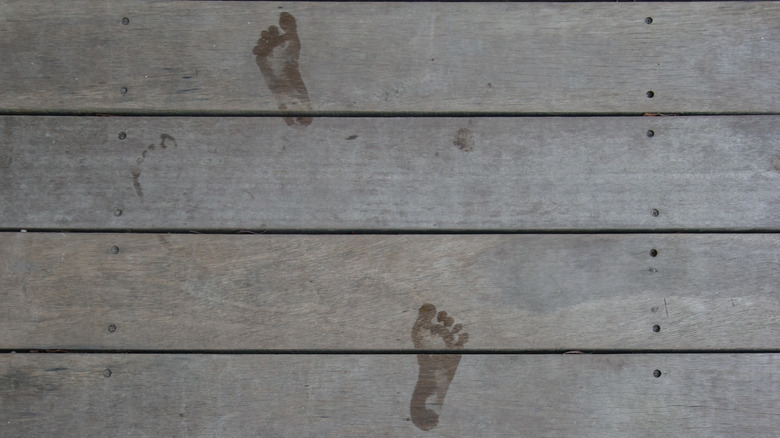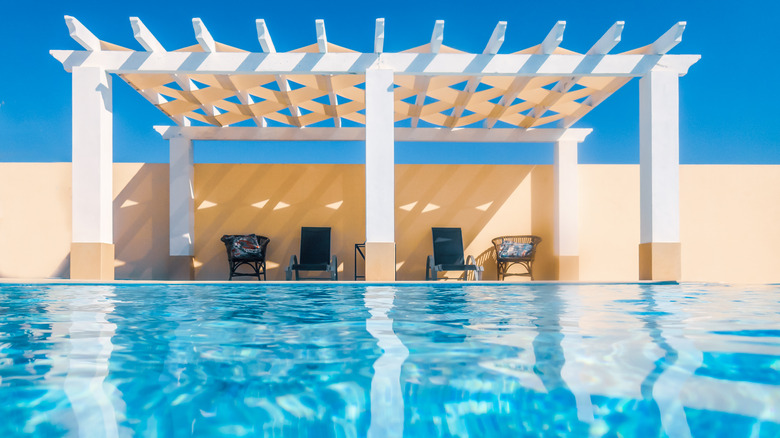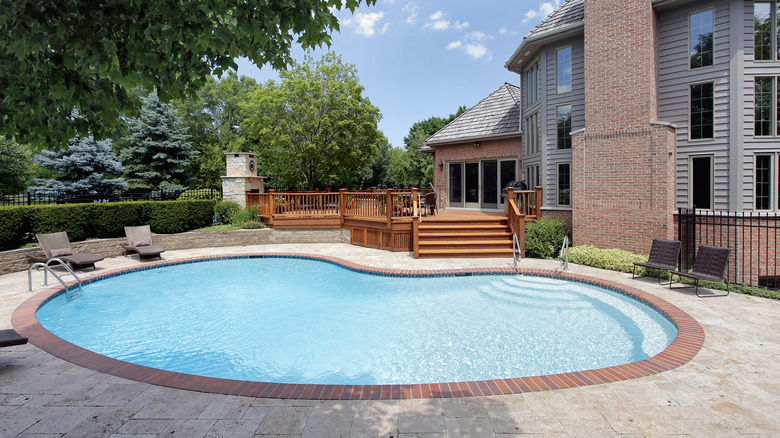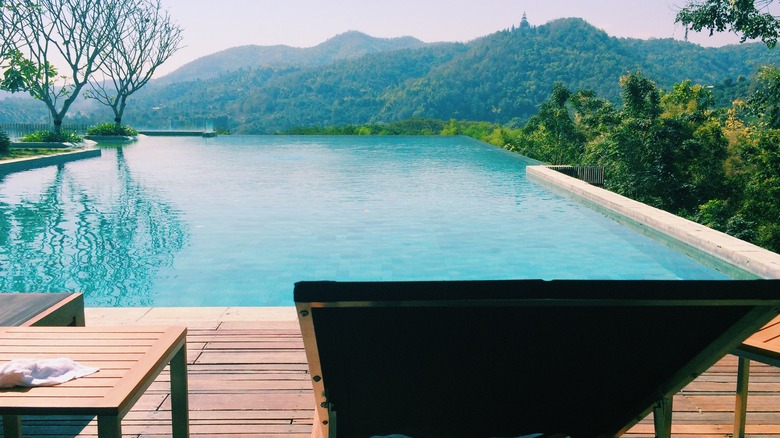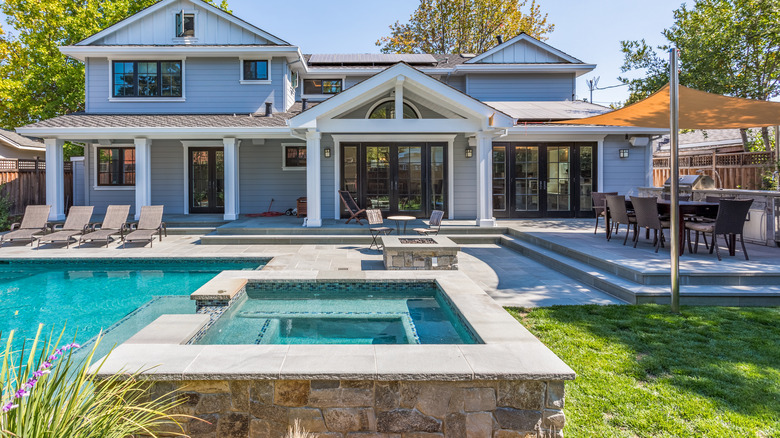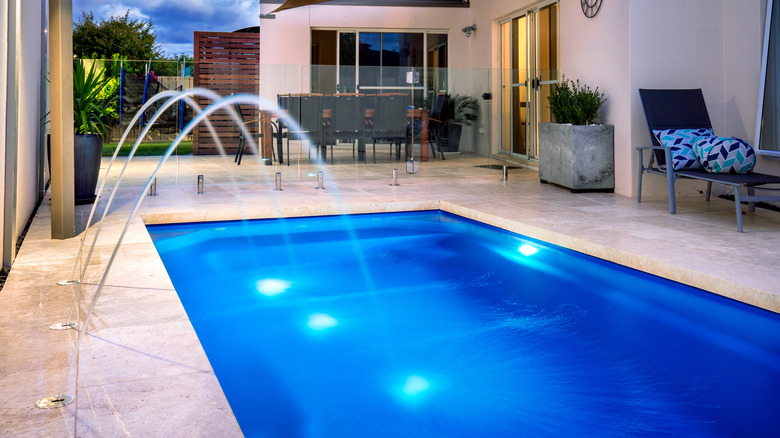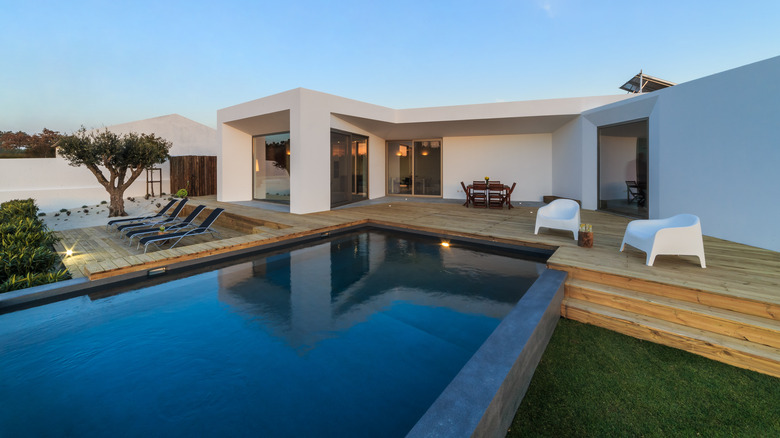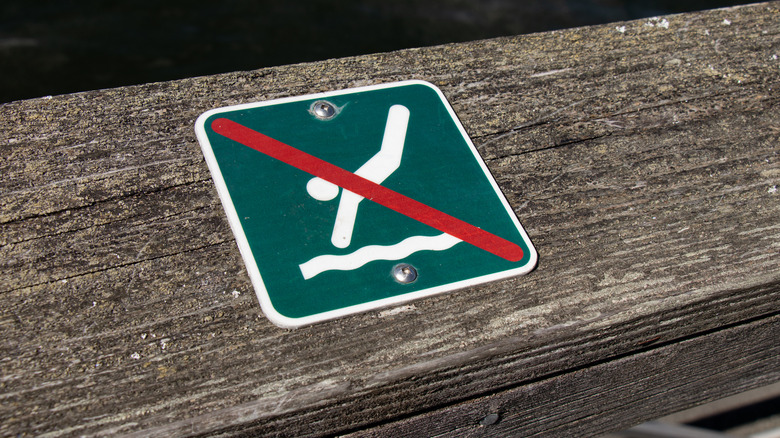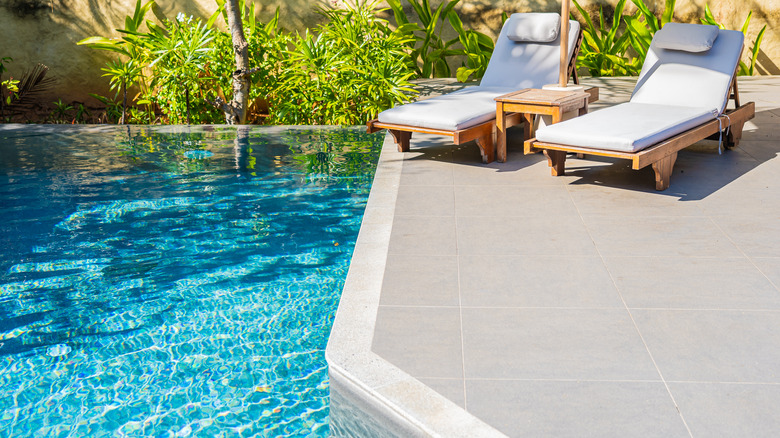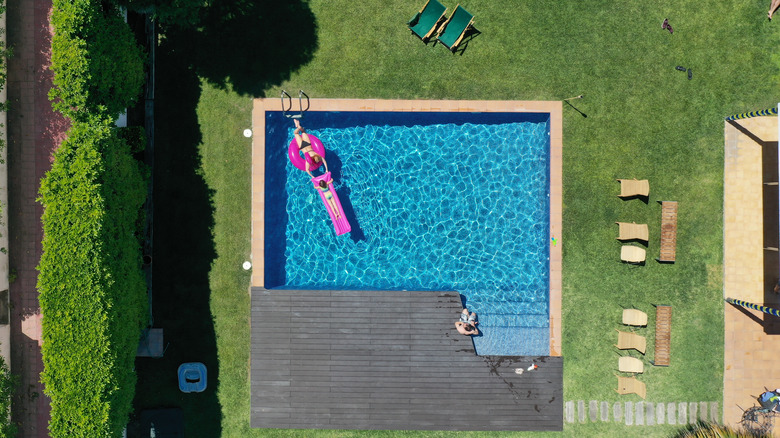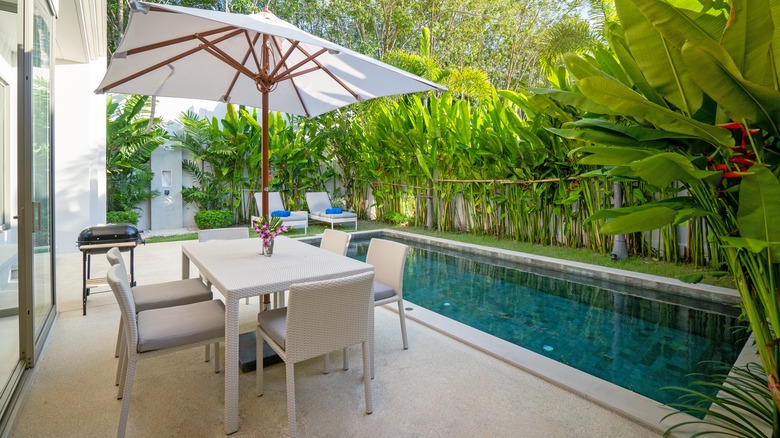15 Genius Tips For Designing Your Pool Deck
If you've decided to install a swimming pool in your backyard, congratulations! Your body will thank you during the long, hot summers to come. However, as you set about planning and designing your pool and deck, it's hard not to get overwhelmed with all the choices that exist on the market these days. Pools can come in all different shapes, sizes, and depths, and feature a wide variety of materials. The immediate area around your pool, known as the deck, is where you'll place your lounge chairs, umbrellas, outdoor dining tables, and any other decorations you choose. This space holds endless design opportunities to make it truly your unique, outdoor haven.
When you start designing your pool deck, you'll come up against a number of pertinent questions, including which material to use for the base, what colors will prevent burnt feet under a hot sun, and how to make the surface material slip resistant, as per Elle Decor. Depending on your particular tastes, you may prefer placing comfort above style or vice versa. Your deck may also need to be designed to take into consideration other members of your family, including children and pets. In the following slides, we'll walk you through 15 of the most important design questions to consider and how to tackle them in order to create the perfect pool deck for your location, lifestyle, and needs.
1. Choose the right color
If your tastes skew more towards the darker side, this tip may come as a bit of a disappointment but could go a long way in preventing serious injury. Sundek points out that when it comes to choosing a color for the material or stain of your deck, lighter is always better. This is because lighter colors reflect the hot rays of the sun as opposed to absorbing them.
Many materials used in deck construction, including wood, concrete, and PVC all come in light or neutral shades that are perfect for keeping the space around your pool cool to the touch and preventing burnt feet.
2. Prevent deck warping
When we talk about deck warping, we're referring to the shrinking and expanding of the boards that make up a wooden deck. According to North American Deck and Patio, warping occurs when the wooden boards are exposed to moisture in the air or on the surface itself; this moisture causes the boards to expand. When the moisture evaporates from the boards, they shrink. This process can create permanent defects over time.
Fortunately you can preventing deck warping. You'll want to choose the right lumber for your deck, specifically boards with straight grain markings and higher density. You'll also want to apply a sealant to the boards at both ends to prevent moisture absorption.
3. Plan before you build
Many people make the mistake of installing their pool deck before taking into consideration how they will set up electricity lines, lighting, and irrigation to the deck, according to Elle Decor. For example, if you're interested in embedding pool lights for nighttime enjoyment, you'll need to factor in how you'll wire the lights and where they will run underneath the deck. Similarly, if you have plans for vegetation around your pool, it may be easier to set up an irrigation system rather than hand-watering the plants.
The solution to making sure these issues don't get overlooked is simple: just make sure you don't start setting the material for your deck without placing the essential electrical and irrigation systems first.
4. Consider foot traffic
According to Decks.com, one of the major factors in a free-flowing deck design is planning for foot traffic. You will want to make sure there is enough room for people to comfortably circulate the entire deck area without having to navigate outdoor furniture or decorations. If your deck hugs the house, you'll also want to design a clear path from the door of the house to the pool. If it doesn't back up to the house, you can also create a pathway out of boards or flat stones.
Additionally, guardrails can be used in the case of a raised deck around an elevated pool to prevent fall accidents, especially when it comes to young children and pets.
5. Plan for shaded areas
Most backyard pool designs exclude large trees or bushes around the immediate vicinity. This makes the pool easier to keep clean and allows the sun to penetrate to the pool while people are swimming. However, as much as direct sun makes cooling off in the pool a much more satisfying experience, you'll still need to create some shade over a portion of your deck area to provide some relief.
Decks.com recommends a pergola or similar structure, which allows you to personalize the amount of shade your deck receives by offering a variety of different slat widths. An awning or umbrella can also be used in particularly sunny parts of the deck.
6. Prevent slippery surfaces
If you've ever been to a public pool, you're well aware of the "no running" policies that are typically strictly enforced. Pool decks can get slippery, especially when consisting of non-slip-resistant materials, such as polished tile.
Elle Decor recommends carefully considering the type of material you choose for your deck surface to avoid slip accidents. Many materials are naturally slip resistant, such as wood, while others can be made slip resistant. For example, if you choose concrete for your deck material, leaving it unsealed and adding texture keeps it from getting slippery when wet. If natural stone is more your thing, make sure it is unpolished. Slate and travertine tiles are popular choices for their anti-slip properties, as per Build Direct.
7. Consider the location
The deck material you choose will be based on several factors, one of which is location. If your home is located in a relatively flat area, you'll have more options for decking materials than if your yard is uneven or placed on a hill. While leveling your yard is always an option, it is expensive and not a prerequisite for creating a beautiful, level pool and deck.
The good news is that the material you choose for your deck can help create a level area if you happen to live on a hill, according to Elle Decor. The website recommends wood boards for anyone dealing with elevation changes as it is much easier to compensate for uneven terrain with a wood-designed structure.
8. Use a combination of materials
If you want a unique outdoor space, consider playing around with different construction materials. In The Swim: Blog suggests incorporating wood, concrete, and brick into your deck design to give your pool deck character. You can apply the same concept to the structures found on your deck, such as a poolside barbeque area, raised hot tub, and eating area.
One stylish idea is to use concrete tiles around the immediate exterior of the pool while placing a slightly raised additional deck surface made from wooden boards along one edge of the pool. This wooden feature adds texture and visual diversity to the space.
9. Consider extra water features
If your budget allows for extra splurges, why not add a water feature to your pool deck? According to River Rock Resurfacing, additional water features take your pool to the next level and make it appear even more luxurious. Examples of water features include jets, waterfalls, and fountains.
No matter which water feature appeals to you, they will all need to be taken into consideration when you design and build your pool deck. Fountains and waterfalls often require an additional structure placed along one edge of the pool, which can be made of brick, wood, or stone. Jets typically emerge from the surface of the deck itself through a small hole.
10. Take into account drainage
When you design and build your pool deck, an important factor to consider is how water will drain off the deck, per Bob Vila. If the deck you are planning is particularly large, you will need to construct it at a slight incline to prevent water from pooling on the surface and potentially damaging the materials.
Alternatively, consider installing a channel drain, which features a long drainage grate on top of the deck that allows water to fall through and move away from your house and yard via a human-made trench. This foresight will be incredibly helpful in the case of a storm or accidental pool overflow.
11. Take care of necessary legalities
Before getting to work on your pool and deck, don't forget to take care of a few routine legalities, including acquiring necessary building permits and apprising local utility companies of your intent to dig into the ground, advises Bob Vila. There may be utility lines running through your yard that you are unaware of. Checking up on this prior to getting started can prevent costly errors down the road.
Additionally, many states and towns have restrictions on how you can build pools and decks, depending on the material. Finally, you may be required to install specific fencing and/or signs notifying neighbors that you have a pool in accordance with state laws, reports Signs.com.
12. Decide the right size
Before beginning construction, you'll need to determine the size of the pool deck as it pertains to your needs, advises Blue Haven Pools. Make sure you consider not only the area available to you in your outdoor space but also the current and future needs of your family.
For example, first determine how many people will be using the pool and if this number will increase over time. You'll also want to determine whether you plan on entertaining visitors and if so, the maximum number of people you'll likely host at one time. You might also want your deck to allow for other poolside activities, such as lounging, playing, having a barbeque, etc.
13. Stay within your budget
Your overall budget will determine which materials you purchase to construct the pool deck of your dreams. According to Florida Pool Patio, anyone looking for truly affordable deck material will want to choose concrete. While there are a few drawbacks, such as cracking and lack of slip resistance, there are ways around these issues that will provide you with a stylish and functional surface without breaking the bank.
Wood is a medium-cost option that offers a wide variety of types, colors, and styles, while tile is another moderately priced material that can be easily and widely customized. Stone is the most expensive material, although one of the most attractive as well.
14. Opt out of decking materials altogether
Just because you have a pool doesn't mean you need to invest in a large and expensive deck to surround it. House Beautiful lets its readers know that a simple concrete edge around the pool is all that's necessary for a border.
Instead of purchasing a bunch of materials and spending your time designing a pool deck, just go the natural route and let the grass serve as the deck. Not only does this option incorporate more of the green scenery of your yard, it also naturally absorbs splashed water from the pool and provides a soft, cool surface to walk barefoot. A middle-ground option is to build a compact deck along one edge of the pool and leave the other sides au natural.
15. Don't rush the process
As you tackle your pool deck installation, remember that you've endeavored on a marathon, not a sprint, advises Elle Decor. Making sure that everything gets installed properly takes time and patience, and it is better to avoid rushing to finish your deck.
The idea is to create an outdoor space that will last for years to come while avoiding potential hiccups down the road caused by not taking your time, such as cracking in the surface material due to not properly leveling and compacting the ground beneath. Your hard work and patience will surely pay off in the end with a beautiful pool deck that will provide the perfect escape in your own backyard.

